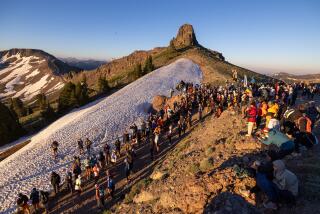Riding Doggedly : Iditarod Trail Is Tough Enough for Teams of Huskies, but Even Rougher When Your Bicycle Has a Flat Tire
- Share via
He carried three spare inner tubes, but had five flat tires. For John Stamstad, ultramarathon cyclist, it was not a particularly joyous time in the Alaskan wilderness.
Stamstad was competing in February’s Iditasport, a 190-mile mountain bike race across the frozen tundra. He eventually finished third, despite the flats.
As a rookie Iditasport competitor, Stamstad was unaware that most cold-weather riders glue their tires to the rims to prevent the tire from slipping and tearing the tube.
As Stamstad rode, his valve stems tore, ripping holes in the tubes that could not be patched. Making matters worse, the flats occurred every time he passed eventual second-place finisher Carl Tobin of Flagstaff, Ariz.
The first two times, Stamstad, 26, thought little of it. But after a backbreaking one-hour rally helped him pass Tobin for a third time, his tire went flat 100 yards down the road. “For no apparent reason,” Stamstad recalled.
After the fourth time, “I thought I was in the Twilight Zone,” he said.
By then, Stamstad was out of tubes, so Tobin gave him his last spare and sped off. Stamstad again passed Tobin. So, of course, a mile later he had a flat and had to make a decision.
Should he ride to the next checkpoint, risking ruining his tire and rim, or wait for the fourth-place rider who might give him yet another spare?
He rode on the flat.
“I rode absolutely as hard as I could for over three hours,” he said.
He lost 1 1/2 hours to Tobin, but his wheel, remarkably, was undamaged. The flat was fixed at the checkpoint, where a mechanic glued the tire to the rim. He pedaled on without further mishap.
Twenty-four hours after starting the trek, Stamstad crossed the finish line at Big Lake, Alaska. Despite the disappointment of mechanical failures, he rejoiced in the achievement that five months earlier had seemed impossible.
Last September, Stamstad was assaulted while on a training ride along the San Gabriel River Trail near the City of Industry and Pico Rivera. He suffered a compound skull fracture after being struck in the head from behind by the assailant, who stole his $1,500 road bike.
Stamstad could not recall any details of the incident, and City of Industry police said they have nothing to go on.
“As I remember, it happened so quick I couldn’t react or anything,” Stamstad said four days later. “Next thing I remember is the staple gun shooting staples in my head to close up the wound.”
Stamstad was preparing for a three-day race through the Mojave Desert when he was attacked. The race was one of two qualification events for this summer’s Race Across America, from Irvine to Savannah, Ga., which Stamstad still hopes to complete.
Shortly after the incident, Stamstad thought he would return to training within a week. His recuperation lasted more than two months.
“I was really messed up for a few weeks,” he said. “My balance was off. I couldn’t shift focus real well.”
Stamstad, a Cincinnati photojournalist, said he could not glance behind him while riding a bike or focus on something out of the corner of his eye, nor could he test his endurance without suffering spells of fatigue.
After a particularly grueling four-hour ride in the Kentucky hills, he said he slept for two days, adding: “I certainly lost a lot of confidence.”
By Thanksgiving, he started feeling stronger. Stamstad targeted Iditasport as his first major test. The Iditasport is a mountain bike, cross-country ski and snowshoe race that usually draws about 60 competitors, who choose which discipline they will enter. It even lures a few zealots who do it all--bike, snowshoe and ski the course, which covers the first 100 miles of the Iditarod dog-sled race, and has been an Alaska tradition for six years.
“It’s a midwinter marker,” said Scott Nissenson, race coordinator. “You go stir-crazy here.”
Stamstad rode a $3,000 titanium-framed mountain bike made by Carpinteria builder Steve McMahon. Except for his encounters with Tobin, he was alone on the trail.
“It was very peaceful . . . calming,” Stamstad said, adding that he was afraid of confronting moose, who are not known for respecting right-of-way courtesy.
“You see a lot of moose prints,” he said. “Once it gets dark and you can’t see things really well, you see a tree and it looks like a moose or a grizzly bear . . . your imagination goes.”
Competitors benefited from a full moon, which was like a beacon in the night.
Stamstad kept contact with fellow humans by watching the tire imprints of the two riders in front of him. Competitors left distinct markings in the snow depending on the type of wheel arrangements they used. Stamstad used conventional tires, but others welded two rims together so they could use extremely wide tires for better traction.
Once in a while, Stamstad noticed a huge body print on the trail where eventual winner Rocky Reifenstuhl had fallen. Reifenstuhl, an Iditasport regular, said he has problems with sleep-deprivation. He falls asleep, then falls off his bike.
“I fell one time and lay there in the snow, praying that I could just go to sleep for two minutes,” he told VeloNews.
Stamstad also crashed, but compared to falling on asphalt, it was undramatic. Crashes in the snow are more cartoon-like. When the front wheel hits a soft spot, the bike abruptly stops, and the rider is flung over the handlebars.
“It’s kind of fun,” Stamstad said.
Those unfortunates who skidded off the trail and fell into snowbanks have another word for it. The powder-like snow beyond the packed trail was five- to six-feet deep.
“It’s like quicksand,” Stamstad said.
The most dangerous aspect of the harsh elements is the weather. Temperatures ranged between zero and 35 below zero, but no one suffered anything worse than minor frostbite.
“You really can’t stop or the sweat will collect and cool you off,” Stamstad said.
So, he did not change clothes, and only stopped to refill water bottles, fix flats or check in at designated points.
Skirting disaster along the route is one thing, but competitors also must contend with the aftereffects of exposure. Stamstad said no matter how much clothing he wore, he shivered for three days after the race.
“And all my exposed skin was on fire,” he said. “It really messes up your body for a while.”
Not that Stamstad was complaining. As one of the country’s best ultramarathon bicyclists, he revels in the vagaries along America’s highways and byways.
At the Humor in Bloomington 24-hour time trial last year, Stamstad and his comrades encountered hostile Indiana residents who were angry that their roads were closed for a day. The race was held over a 23-mile loop course.
Stamstad, who won the event by riding 130 miles, said some tried to sabotage the race by putting tacks and dead snakes along the course.
“And they let a bull out into the road in front of the cyclists,” he said. “Support vehicles got flat tires. Riders narrowly avoided the bull. Someone got run off the road by a car.”
He picked Iditasport because he thought it would be more interesting than “something that goes around in circles.” Besides, the course was a 1 1/2-hour drive from Anchorage, the nearest population center.
“You really can get in a lot of trouble,” he said of the vast, empty land.
“All it takes is to get lost at night. There is nothing out there. No 7-Elevens, no gas stations. Just you and the snow.”
Not the ideal spot for a flat.
More to Read
Sign up for The Wild
We’ll help you find the best places to hike, bike and run, as well as the perfect silent spots for meditation and yoga.
You may occasionally receive promotional content from the Los Angeles Times.






